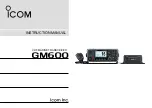
21 /87
4
INSTALLATION AND ACTIVATION
4.1
INITIAL CHECK
The equipment becomes the property of the customer when the equipment is delivered to the
carrier. Carefully unpack the transmitter. Perform a visual inspection to determine that no apparent
damage has been incurred during shipment. All shipping materials should be retained until it is
determined that the unit has not been damaged. Claims for damaged equipment must be promptly
filed with the carrier or the carrier may not accept the claim.
The contents of the shipment should be as indicated on the packing list. If the contents are
incomplete, or if the unit is damaged electrically or mechanically, notify both the carrier and the
supplier.
CAUTION: Before switch the equipment on, ensure that all RF Loads, RF cables and connectors
are properly connected. To prevent damage to the amplifiers, it is essential that either the feeder and
antenna system or the dummy load have a good in band return loss.
Failure to observe the above caution and also the installation instructions of this amplifier may
cause damages to the amplifiers for which the supplier cannot be considered responsible.
PREVENTION OF ACCIDENTS
When it is used in normal applications and within the parameters defined in the technical
specifications, this equipment does not endanger health and safety, provided that normal operating
and engineering safety practices are observed and that it is used only by authorized, trained and
qualified personnel.
THERMIC AND ENVIRONMENTAL CONDITIONS
- A too high environmental temperature (in any case not higher than 45°C) shall cause a non-
adequate rack cooling putting the equipment in hard working conditions.
- An air conditioner should be installed to keep the room temperature constant even in case of
external temperature variation.
















































